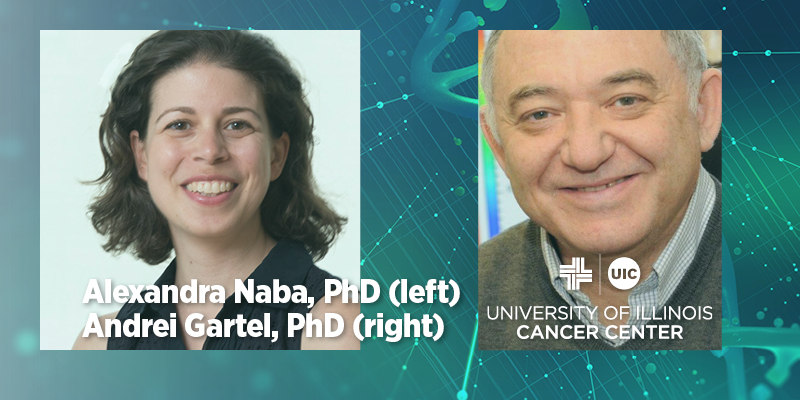
And the winners are…
The University of Illinois Cancer Center has selected two teams of scientists to receive $50,000 research grants as part of its pilot grants program, whose purpose is to stimulate new interprogrammatic research initiatives that will lead to competitive grant applications submitted to external peer reviewed funding organizations. The grant recipients are:
Alexandra Naba, PhD, Assistant Professor of Physiology and Biophysics, College of Medicine
Steve Seung-Young Lee, PhD, Assistant Professor of Pharmaceutical Sciences, College of Pharmacy
Yu Gao, PhD, Assistant Professor of Pharmaceutical Sciences, College of Pharmacy
Joanna Burdette, PhD, Professor of Pharmaceutical Sciences, College of Pharmacy
Single-cell spatial proteomics for geographic profiling of the cellular and extracellular protein expression in ovarian tumors
A study conducted in Illinois’ Cook County found that Black women were more likely to die from high-grade serous ovarian carcinoma (HGSOC) as compared to European-American women. Abnormal protein expression in ovarian tumors is strongly associated with disease progression. In order to develop effective therapies for HGSOC, it is critical to understand the regulation of cellular and extracellular protein expression in disease progression. The research team proposes to develop a single-cell spatial proteomics technology for dissecting the protein expression in HGSOCs.
By combining high-resolution microscopy conducted by Steve Seung-Young Lee with highly sensitive proteomics undertaken by Yu Gao and Alexandra Naba, the analysis will simultaneously provide spatial and quantitative expression level information for thousands of proteins in high-grade serous ovarian carcinoma.
“We believe our research results will dramatically improve the depth and breadth of our knowledge on the protein expression in ovarian tumors, and thus contribute to the development of highly effective therapies for African-American patients with the disease,” Naba said.
Aims
Develop a 3D multiplex fluorescent coding method using photobleaching in optically cleared ovarian tumor macrosections.
Develop a robust workflow for single-cell 3D spatial proteomic analysis of cellular and ECM protein expression in HGSC.
Andrei Gartel, PhD, Associate Professor of Molecular Genetics, College of Medicine
Irum Khan, MD, Assistant Professor of Clinical Medicine, Division of Hematology/Oncology, College of Medicine
Michael Chesnokov, PhD, postdoctoral fellow
Targeting of FOXM1 in AML
Acute myeloid leukemia (AML) is one of the most common types of leukemia in adults, although it is fairly rare, accounting for only about 1% of all cancers. About 19,940 new cases of AML will be diagnosed this year, and the disease is expected to cause 11,180 deaths, almost all in adults.
The outcomes from AML have remained abysmally poor for the past 30 years, with 20% to 40% of patients failing to achieve remission with induction chemotherapy, and 50% to 70% of patients achieving complete remission relapse within three years, Gartel said. A major breakthrough in dissecting out prognostic subgroups came with the discovery of the nucleophosmin (NPM1) mutation in 40% to 60% of cytogenetically normal (CN)-AML cases.
Subsequent analyses has demonstrated that AML patients with wild-type FMS-like receptor tyrosine kinase (FLT3) bear mutated nucleophosmin and shows improved overall survival and relapse-free survival. NPM belongs to the nucleophosmin/nucleoplasmin family of chaperones, which are ubiquitously expressed in mammalian cells. FOXM1 interacts with NPM in AML cells and FOXM1 and mutant NPM are sequestered in the cytoplasm where FOXM1 is inactive. Preliminary data indicates that nuclear, but not cytoplasmic, FOXM1 is responsible for unfavorable outcomes of AML treatment.
“Targeting nuclear FOXM1 by small molecules may improve the outcome of AML patient treatment,” Gartel said. “We identified a novel compound – STL427944 – that inhibits FOXM1 in AML. We will test several hypotheses to determine the pharmacokinetics and efficacy of novel FOXM1 inhibitors in AML mouse models.”
Aims
Determine whether the activity of the FOXM1 regulatory network correlates with the favorable/unfavorable outcomes for AML patients.
To determine pharmacokinetics and efficacy of novel FOXM1 inhibitors in AML-M5 mouse models.
